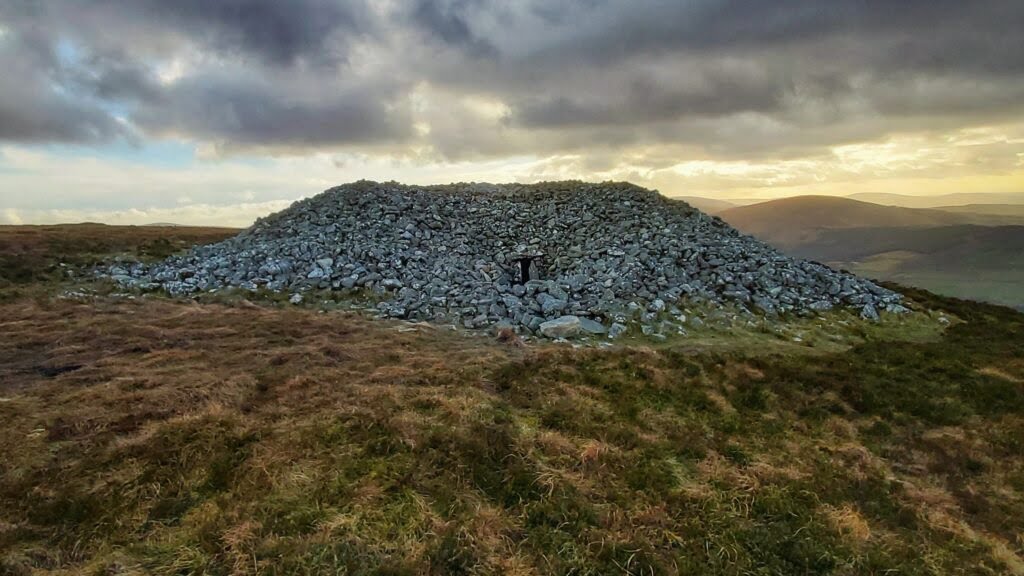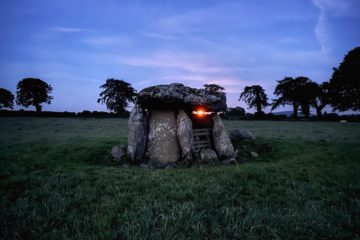
Today I had the pleasure of hiking up to Seefin Passage Tomb for the first time. This tomb, hidden away in the Wicklow Mountains, is one of the best preserved and most isolated sites I have ever visited. There is quite a bit of a hike to reach the summit where the passage tomb is, but if you can manage the stony climb you won’t regret the effort. The 5000-year-old monument is simply awe-inspiring, and the chances are that you will have it all to yourself!
Getting There
Before you even begin the hike, you’ll need to drive out there and find a place to park. If you put ‘Seefin Passage Tomb’ into Google maps it will take you to the road that runs along the base of the mountain. If you are coming from the direction of the Sally Gap, you will eventually pass Kippure Estate on your left. Take the next right turn immediately after Kippure, and after a few seconds you will come to a lay-by on the right where you can leave your car. It’s almost directly opposite the ruins of a small stone cottage in a field on the left.
Once you’ve parked, you walk back a few metres past the ruins of the cottage. You will see the edge of a forest going up the mountain in a line, and at the foot of this is an entrance to a stony track that goes up alongside the line of trees. Follow this until you reach the top of the tree line. The track then turns right and you continue to follow it until it turns sharply left again. Then just keep going straight up until you reach the top and see the tomb looming in front of you. In total the hike should take you around 45 minutes to an hour at a slow to moderate pace.

The Tomb
The tomb itself is a stark grey sight between the grassy mountaintop and the sky. It consists of thousands of rocks piled in a circular mound with a narrow entrance framed by long, narrow stones. When you make your way over to the entrance, you really do feel as though you are looking into a portal to another world. It has actually been speculated that the monument quite literally symbolises an entrance between worlds, as the mound resembles a pregnant belly and the doorway bears resemblance to a woman’s vulva.

The tomb is 5000 years old, built around 3000BC. Believe it or not this makes it around 500 years older than the great pyramids of Giza in Egypt, what a treasure to have here in Ireland! For our ancestors to have built this incredible monument so long ago is an amazing feat of engineering, especially when you consider that the site is 1700 feet above sea level. The tomb itself is 75 feet in diameter, and around 18 feet tall. Inside the tomb there are 5 internal alcoves, even more than our most famous Neolithic tomb, Newgrange, which only has 3. It has been recorded that there is megalithic art on the entrance stones, but unfortunately we couldn’t make any out on our visit.
The views from the site are absolutely breath-taking, and even without the incredible history it would be enough to bring a tear to your eye. It has even been said that if the day is clear you might be able to catch a glimpse of Newgrange, far away in County Meath.

In the surrounding hills of Seefingan and Seahan there are two other cairns. Unlike Seefin, these sites have never been excavated and remain sealed to this day. The excavations at Seefin took place in 1931 and were conducted by R.A. Macalister. Strangely, there were no human remains found inside, or indeed any artefacts at all. There could be several reasons for this; perhaps the tomb was robbed at some point in its long history, or perhaps our ancestors removed them to bring along to a new homeland. We will probably never know for sure, but it seems strange after building such a huge and impressive tomb that our ancient relatives would leave it bare. It would be fantastic to do excavations on the nearby tombs and see if they can shed any light on the mystery. Hopefully we will see this happening at some point in the future.



